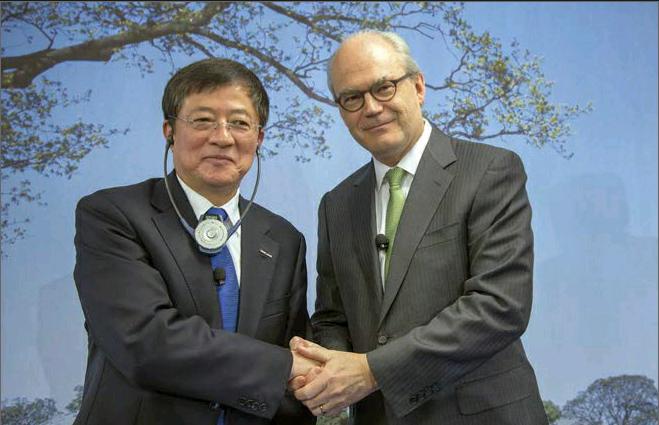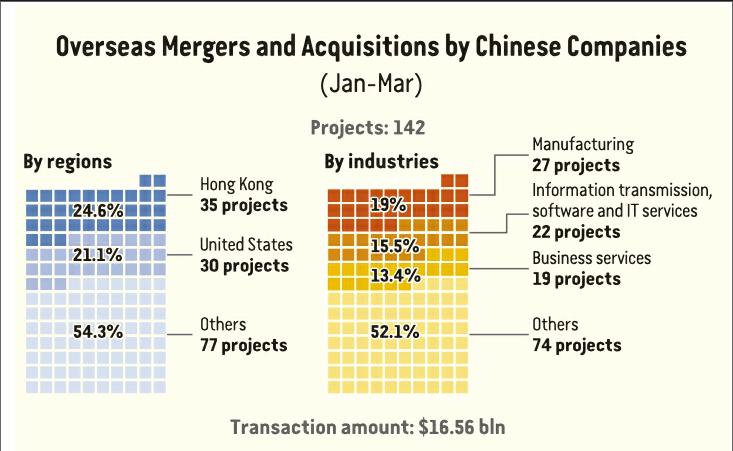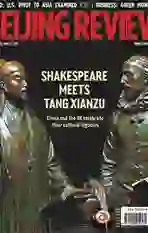Booming Overseas Purchases
2016-06-08ByWangJun
By+Wang+Jun


Chinas cross-border mergers and acquisitions (M&As) increased in the first quarter, but Chinese and Western sources have differing explanations for the uptick.
The Chinese Ministry of Commerce(MOFCOM) reported that Chinese companies had 142 overseas M&A projects during the first quarter of this year. The transaction amount totaled $16.56 billion, according to Shen Danyang, spokesperson for the ministry, who revealed the total at a press conference held on April 19.
Overseas sources are reporting different numbers, however. An analysis by Thomson Reuters shows that Chinas crossborder activity totaled $95.1 billion during the first quarter, a 136-percent year-on-year increase. A Bloomberg report on March 30 said that the number is closer to $113 billion, which tops the total value of 2014 deals and is close to last years record $121 billion.
Yang Liqiang, Deputy Director of China Research Center for Foreign Direct Investment under the University of International Business and Economics, attributes the differences to differing statistical methods used to calculate the number and said the discrepancy is normal. But without doubt, cross-border M&As are booming this year compared with 2015, particularly during the first quarter.
“This also indicates that Chinese firms have entered a new stage of going global, and M&A has replaced setting up branches to become a major way for Chinese firms to explore the global market,” Yang said in an interview with 21st Century Business Herald, a business news paper published in Guangzhou, Guangdong Province.
A surge in deals
The large discrepancy between the foreign M&A amounts and the total released by MOFCOM could be attributed to some organizations including deals that are still undergoing negotiations or have been in the works for a period of time but are just now being completed, Shen said at the conference.
For example, China Three Gorges Corp.s purchase of 30-year concession rights to operate two Brazilian hydropower plants, which involves a total investment of$3.7 billion, is the largest overseas merger, according to MOFCOM data. However, among those announced in the first quarter, the largest deal is actually ChemChinas$43-billion bid for Swiss pesticide and seed giant Syngenta.
“The figures we see now are very enormous, but some of the projects have been negotiated for years and they are completed in the first quarter this year,” Yang said.“A few mega deals have also pushed up the total value of cross-border M&As.”
Chinese companies carried out 593 overseas M&A deals in 2015, according to MOFCOM, with the actual transaction amount totaling $40.1 billion. The first quarter of this year recorded a transaction amount of $16.56 billion.
Yang said that faced with excessive production capacity and volatile capital markets, many Chinese firms have explored the global market to combat weak domestic demand, promoting the surge in crossborder M&As.
A report from Everbright Securities Co. Ltd., a state-owned brokerage firm, said that overseas M&As have become an effective way for Chinese firms to overcome bottlenecks created by weak domestic and external demand in the market.
For these reasons, Chinese firms prefer to acquire foreign companies manufacturing middle- and high-end consumer products and those in emerging industries. While Chinese companies focused on acquiring mechanical manufacturing companies during the 2002-05 period and energy and resources firms from 2008 to 2010, today they are targeting emerging industries and the service sectors, said Ding Jihua, deputy director of the research and consulting department of Beijing New Century Academy on Transnational Corporations.
Huo Jianguo, former president of the Chinese Academy of International Trade and Economic Cooperation under MOFCOM, said the explosive growth in overseas M&As may be due to Chinese companies concerns over the yuans volatility. Buying foreign assets is a solution to diversifying some of this financial risk.
But Shen maintains that the size and speed of growth of overseas M&As is normal. Chinese companies are still in the beginning stages of overseas M&As, he said. Despite the high growth in transaction value in 2015, Chinese firms made up just 6.2 percent of the worlds total overseas M&As.
Potential risks
But its not all sunshine and roses. Without adequate experience and professionals to work with them to address policy and cultural differences in overseas markets, Chinese companies face potential risks, Shen said.
“Major problems for investments in developing countries are usually the exchange rate fluctuation and inadequate financing channels concerning social stability and security. Major problems for investing in developed countries are the challenges brought by different rules in these countries, such as affairs involving trade unions and legal services,” said Su Li, Greater China Head of Ernst & Young Transaction Advisory Services, in an interview with 21st Century Business Herald.
She added that it is vital to control the speed of M&As because Chinese companies are often unable to assess risks since they are new to cross-border M&As. This is especially true when they are facing a tight timetable for a merger or acquisition.
Getting local governmental approval is also a major challenge for companies looking to acquire overseas firms. “Chinese companies may not fully disclose information, and the local media will impose some pressure on the government for the approval of M&A projects,” said Gabriel Wong, head of China Corporate Finance of Pricewaterhouse Coopers LLP.
To avoid these problems, Chinese firms need to have clear strategic decisions and carry out due diligence on the local business, political and even cultural environments.
“Before making overseas M&As, it is very important to have clear strategic targets—obtaining technologies or expanding markets,” said Su, adding that Chinese firms can start due diligence investigations as soon as they develop these targets.
Chinese firms will also need to conduct thorough research into cross-border M&As, as they are often different from those in the domestic market, Wong said.
“Legal systems, business logic and customs, financial and taxation systems, human resources and trade union organizations are all different from those in China, so Chinese companies M&A experience in the local market will not work for crossborder M&As,” he said.
Chinese companies should pay special attention to three aspects when carrying out due diligence investigations for cross-border M&As, according to Wong.
The first being human resource issues such as social security systems, which are often different from that in China. Integrating IT systems is another necessity.
“To Chinese manufacturing companies, investigating environmental protection policies in the target market is very important,” Wong said. “Environmental policies in foreign countries are stricter than those in China. Chinese companies may have to pay higher costs than they normally would in China to meet the environmental protection standards.”
Chinese firms are also reminded to communicate with stakeholders.
“Chinese buyers should communicate not only with buyers and shareholders, but also with stakeholders such as trade unions and local governments to make human resource arrangements and development plans for after the transaction,” Su said.
